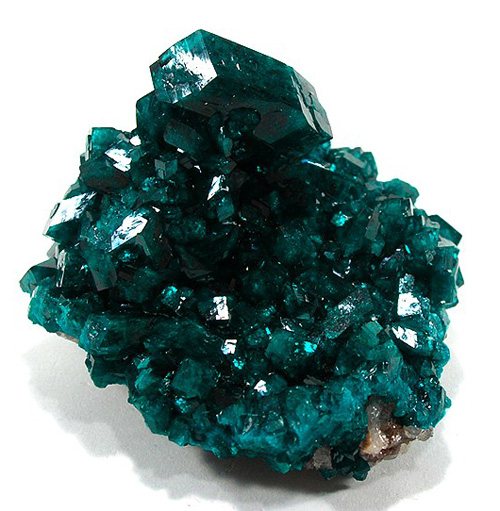The Mineral dioptase

Dioptase is a brightly colored mineral, highly desired for its intense green color. It can form in very distinctive, well-developed crystals, but only a handful of well-known deposits have produced large crystals. Most localities of this mineral, including those in Arizona, only produce microcrystals. Dioptase crystals are generally fragile and can easily break or crumble, and therefore care must be exercised when handling specimens.
Dioptase was named in 1797. Its name is derived from a combination of the Greek words Dia, which means "through" and Optasia, which means "to see". This is regarding the ability to see internal cleavage planes within transparent to translucent crystals of Dioptase.
Chemical Formula
Cu6Si6O18 ·6H2O
Color
Deep emerald green, dark green, bluish-green
Properties
Streak
Green |
Hardness
5 |
Transparency
Transparent to nearly opaque |
Specific Gravity
3.3 - 3.4 |
Luster
Vitreous to adamantine |
Cleavage
1,3 |
Fracture
Uneven |
Tenacity
Brittle |
Crystal Habits
In distinct, hexagonally-shaped crystals with pointed, rhombohedral ends. Crystals are almost almost always doubly terminated, and are usually short and stubby, although they are occasionally prismatic and elongated. Crystals may also be more typical rhombohedral, though this habit is very uncommon. Crystals are usually in dense groups of interconnected crystals, but may be as isolated individuals. Also drusy, radiating, acicular, botryoidal, grainy, encrusting, and massive.
Uses
Dioptase is a highly valued mineral, and good crystals are sought out by mineral collectors and enthusiasts. Dioptase specimens, especially those from classic localities, can be quite costly.
Noteworthy Localities
The type locality for Dioptase, known for producing large and exceptional crystals, is Altyn-Tyube, Kazakhstan. Equally exceptional is the famous locality of Tsumeb, Namibia, which has produced what are perhaps the best examples of this mineral. The copper mines of the Kaokoveld District, Kunene Region, Namibia have produced large, isolated and outstanding Dioptase crystals associated with bright blue Shattuckite in very aesthetic combinations. Other important African localities are the Katanga (Shaba) Copper Belt, in the Congo (Zaire); and Mindouli and Renéville, in the Republic of Congo. In South America, good Dioptase crystals come from the Malpaso Quarry, Dumesnil, Córdoba, Argentina.
In the U.S., Dioptase is mostly limited to the state of Arizona, and only in small drusy or encrusting crystals, as well as radiating microcrystals. Important Arizona localities include the Mammoth-St. Anthony Mine, Tiger, Pinal Co.; the Christmas Mine near Hayden, Gila Co.; and the Morenci Mine, Greenlee Co.
Distingushing Similar Minerals
Uvarovite - Different crystal forms and environment and harder.
Malachite and Brochantite - Different crystal forms, lower hardness.